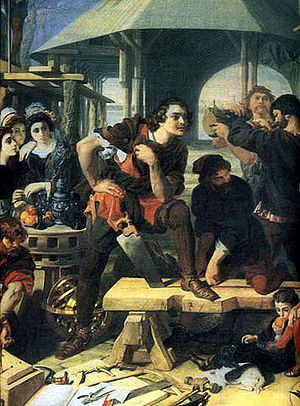Three versions of the origin of the samovar

Today samovars are associated primarily with Tula and are perceived as one of the important elements of the traditional Russian cultural code. Indeed, in domestic conditions, an invention such as a samovar was very useful, especially in the cold season. Today, scientists recognize the samovar as a domestic invention, but in the past there were other versions of the origin of the samovar. Despite the historical fallacy of these versions, they are quite curious from a cultural point of view and therefore worthy of consideration.
The first version is the western origin of the samovar. This version claims that the samovar was brought personally by Peter I from a trip across Europe. It is even called the country where the prototype or concept of the samovar was taken from - Holland. But this version does not have documentary evidence, and in the history of the Dutch way of life at the end of the XVII - beginning of the XVIII century, no mention is made of the use of devices similar to Russian samovars, even in aristocratic circles. Peter I really borrowed a lot from Europe, conducting reforms in the country, so the popular rumor subsequently attributed to him and the borrowing of the samovar, among other innovations. But in Russia samovars started to be produced in the middle of the XVIII century in the Urals (Suksun settlement), that is, 25 years after the death of Peter I
 The second version is the eastern origin of the samovar. A Chinese relative of a Russian samovar is called "Hogo". It appeared in the 16th century. But, despite some similarity of design, Hogo also uses not for making tea. In a broth, heated to boiling, on chopsticks, thin pieces of meat for roasting are dropped. Even if we assume that the inventors of the Russian samovar knew about the existence of Hogo, they had to radically rethink the concept of using the device to create their brainchild.
The second version is the eastern origin of the samovar. A Chinese relative of a Russian samovar is called "Hogo". It appeared in the 16th century. But, despite some similarity of design, Hogo also uses not for making tea. In a broth, heated to boiling, on chopsticks, thin pieces of meat for roasting are dropped. Even if we assume that the inventors of the Russian samovar knew about the existence of Hogo, they had to radically rethink the concept of using the device to create their brainchild.
.jpg) The third and official version is the domestic origin of the samovar. In fact, the history of the Russian samovar is such that it reconciles the western and eastern versions, but not in a historical, but in a symbolic sense. Thanks to the reforms of Peter I, a developed industry appeared in Russia. Without a developed industry, Russian factory masters could not invent and begin mass production of a device so technological at that time as a samovar. There is also a Chinese track in the history of the samovar. But this trace is not "Hogo", but tea is a traditional Chinese drink. Without tea, the samovar would not have been, or it would have taken another place in Russian culture. Thus, Western technologies and Eastern traditions have come together and yielded results in the Urals - in the Russian region which was already considered a symbolic "buffer zone" between the West and the East.
The third and official version is the domestic origin of the samovar. In fact, the history of the Russian samovar is such that it reconciles the western and eastern versions, but not in a historical, but in a symbolic sense. Thanks to the reforms of Peter I, a developed industry appeared in Russia. Without a developed industry, Russian factory masters could not invent and begin mass production of a device so technological at that time as a samovar. There is also a Chinese track in the history of the samovar. But this trace is not "Hogo", but tea is a traditional Chinese drink. Without tea, the samovar would not have been, or it would have taken another place in Russian culture. Thus, Western technologies and Eastern traditions have come together and yielded results in the Urals - in the Russian region which was already considered a symbolic "buffer zone" between the West and the East.
